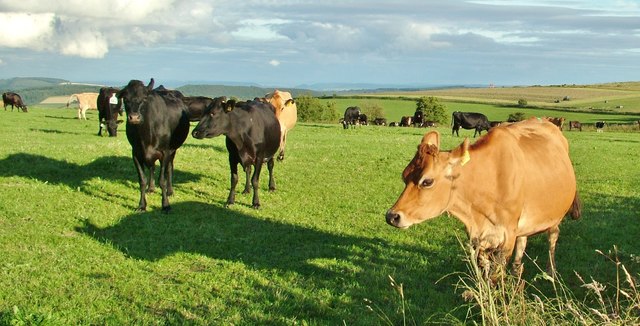
Dairy farms can play a key role in reducing greenhouse gas emissions and cooling the planet, according to researchers. Image: Geograph
Reducing farm greenhouse gas emissions may plant the seed for a cooler planet
Posted on July 24, 2019UNIVERSITY PARK, Pa. — By adopting a few beneficial management practices, farms — and particularly dairy farms — can play a key role in reducing greenhouse gas emissions that are warming the planet, according to a team of researchers.
Based on a series of climate-model projections, the researchers found that if farmers worldwide set a target to adopt practices to reduce their emission of greenhouse gases, particularly methane and nitrous oxide, by just 25 percent over the next 30 years, they could reduce overall warming by 0.21 degrees Celsius, or 6 percent of projected total warming. Scientists have set targets to reduce emissions of greenhouse gases to keep global temperatures from rising 2 degrees Celsius above levels experienced in preindustrial times.
Emission cuts from dairy farms alone could contribute 0.03 degrees Celsius of that temperature reduction, according to the researchers, who reported their findings in the current issue of Environmental Research Letters.
“What we’re trying to understand is the overall impact of dairy farming on climate change and finding out what are the best management practices that can be identified by actually doing experiments on the farm and understanding what effects these practices have on the overall lifecycle of the farm’s greenhouse gas emissions,” said Chris Forest, professor of climate dynamics in meteorology and atmospheric science and associate of the Earth and Environmental Systems Institute.
Most recent attention on greenhouse gases has focused on reducing carbon dioxide emissions, but other gases, such as methane and nitrous oxide, contribute about a quarter of the current volume of total greenhouse gas emissions and may be easier to mitigate than carbon dioxide, according to Forest, who is also affiliated with the Institutes of Energy and the Environment and an associate of the Institute for Computational and Data Sciences. While farm equipment does produce carbon dioxide, agricultural operations are major contributors of methane and nitrous oxide gases. Cows produce methane when they belch, and manure also emits the gas. Farming operations can generate nitrous oxide in the soil, which is then released into the atmosphere.
Forest added that cuts in methane, which, on a per molecule basis, is an even more potent greenhouse gas than carbon dioxide, could have an immediate impact on climate warming because it has a compounding effect on the environment. Not only is methane a greenhouse gas, but it is also photochemically converted to produce carbon dioxide in the atmosphere.
“The big issue is that if we can reduce methane, we can have a stronger and more immediate effect on the reduction of the net radiative forcing and that, therefore, would cool the planet faster,” said Forest.
Net radiative forcing is the difference between the energy absorbed by the Earth and energy radiated out to space. If more energy is blocked by these additional greenhouse gases, then less energy radiates out to space, the planet tends to warm.
According to the researchers, these best farming practices to reduce these gases are focused on three types of farming operations — feeding animals, storing or processing manure, and cultivating crops. Specific practices include no-till farming, sealed flare storage for manure, and high feed efficiency that can reduce cow belches.
The researchers modeled the effects of beneficial practices on a small herd — about 150 cows — on a Wisconsin farm and an industrial-sized farming operation — about 1,500 cows — in New York.
Both small- and large-scale farms have the potential to lower emissions using these practices, however, Forest said the smaller operations have greater potential in mitigating emissions. By implementing best management practices, on a per-hectare basis, a small farm could reduce methane emissions by 53 percent, nitrous oxide by 56 percent and carbon dioxide by 20 percent. In a large farm, the practices would lead to a 43 percent reduction of methane emissions, a 4 percent reduction of nitrous oxide emissions and a 10 percent reduction in carbon dioxide emissions, on a per-hectare basis.
“If you think about the reduction of emissions per gallon of milk produced, you could reduce more methane and nitrous oxide combined in the 150-cow farm compared to the larger 1,500-cow farm,” said Forest.
The researchers developed four long-term scenarios to understand the effects of the reduced emissions as compared with a business-as-usual case. These scenarios assume that agricultural emissions could be reduced by amounts in line with the dairy-farm best management practices, and they would be adopted globally.
According to Forest, who is also a senior Project Drawdown fellow, the beneficial management practices for the dairy industry are example solutions that researchers are proposing to mitigate global climate change. He said that Penn State will host the Drawdown Conference, which will review other innovative approaches to climate change mitigation, in September.
Kristina A. Rolph, the lead author and a doctoral student in meteorology and atmospheric science at Penn State, and Matt Ruark, associate professor in soil science at the University of Wisconsin-Madison, worked with Forest on the study.
The U.S. Department of Agriculture supported this work.
